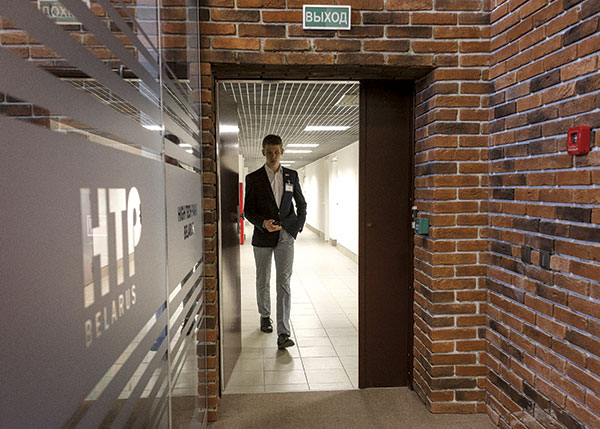High-Tech Park transforms Belarus into a major IT supplier in Europe
Love to study in Minsk
An undergraduate at one of the most prestigious Minsk higher educational establishments — the Belarusian State University of Informatics and Radioelectronics, Maxim Demchenko, speaks of his choice, “This university is connected with IT companies and it will be easier to find a job in the future. I would love to live and work in Minsk and, like my friends, hope to join one of the resident companies in the High-Tech Park.”

High-Tech Park attracts talented specialists
The Belarusian is not attracted by working abroad. “My uncle and his wife went to the USA in the mid-1990s. At that time, Belarusians and Russians were highly thought of by major IT recruiters as we were thought to have a unique ‘Slavonic’ way of thinking. Our people were able to think outside the box and find a solution to virtually unsolvable problems,” the young man says. “My relatives went to earn some money to buy a flat and then planned to return home. It took them five years to accumulate savings. During that time, babies were born and their career was developing. In 2000, they could have returned only to their own flat in Minsk and there were no jobs in Belarus suitable for their qualifications. The situation is different now.”
No longer a brain drain
The situation has changed drastically. Primarily, this has become possible as Belarus has developed its own serious IT industry. The High-Tech Park transformed the country into a major producer of software in Central and Eastern Europe. Established in September 2005 following a Presidential Decree, the Park has already earned $1bn. At present, the HTP annually exports $500m (last year, the figure exceeded $585m) of its produce globally. “Last year, we ensured a 44 percent growth of exports of services in the country’s payment balance,” admits the HTP Director, Valery Tsepkalo proudly; he was among the founders of this grand and successful project.

In the past, a former assistant of the President and a Belarusian Ambassador to the USA spent over a year trying to convince us that Belarus needed generous tax and other benefits for the IT industry and a special venue for high-tech companies. Crucially, we preserved a high level of staff training in the field of electronics and radio-technics. To retain our talented staff, favourable conditions were created for the development of the software industry and the enhancement of export production based on high technologies. High calibre employees do not need to move away when they can find jobs and earn comparable salaries at home. An average salary in the IT sphere is approximately 1,000 Euros, which is not bad for Minsk. As regards the regional centres of Belarus, this money can allow people to have an address to gain bank credit or build a house... and consequently their future. HTP programmers enjoy one of the highest salaries in Belarus, even higher than in most Eastern European states (in the same sphere). Specialists from Russia, Europe, America and Japan work at the Park’s best companies. The HTP is justly proud of gathering a team of true professionals under its roof.
Virtual Park
The HTP has its own peculiar feature: as distinct from most European and Asian colleagues, Minsk’s Park is virtual. Accordingly, its legal regime is operational over the whole Belarusian region. You can register as a resident and use all the advantages of the Park. Moreover, your office can be located anywhere: in a regional centre or a small village. As Mr. Tsepkalo noted at a press conference on the 2014 results, such an approach makes it possible to fully use the country’s educational, scientific-research, professional and infrastructure potential. “The HTP resident companies actively participate in the realisation of major science-intensive projects and industry modernisation. Moreover, 88 percent of the HTP produce is exported, with companies from 56 states of the world being among our customers. 43.5 percent of our exports head for Western Europe, 40.1 percent go to the USA and 14.4 percent — to the CIS,” he said.

Interestingly, a single HTP programmer produces the same added value as fifty workers from the country’s leading companies. Intermediate imports occupy a significant share in exports of the tractor and automobile works while the HTP lacks this. As a result, the Park’s influence on the country’s economy is annually increasing. One of the major tasks for 2015 is the opening of a HTP business incubator. The Park also plans to create the largest venue in the post-Soviet area (and probably in Europe) for freelancers to communicate and work together; among these ‘distance’ employees would be programmers and designers.
Figures alone
Last year, the Park attracted $34.3m of direct foreign investments. At present, 137 resident companies work here — including 58 (42 percent) set up by Belarusian investors. 46 (34 percent) companies of the HTP are foreign and 33 (24 percent) companies are joint commercial organisations. The total number of employees exceeds 20,000.

Citing on the topic
On meeting the President of Belarus, Alexander Lukashenko, the General Director and a co-founder of Siguler Guff & Company investment company, Drew Guff, said, “A saying has been invented by businessmen working in the IT sphere: if you have any job — send it to India; if you have a complicated job — send it to America; if you have a job which is impossible to do — send it to Belarus.”
By Olga Bebenina











